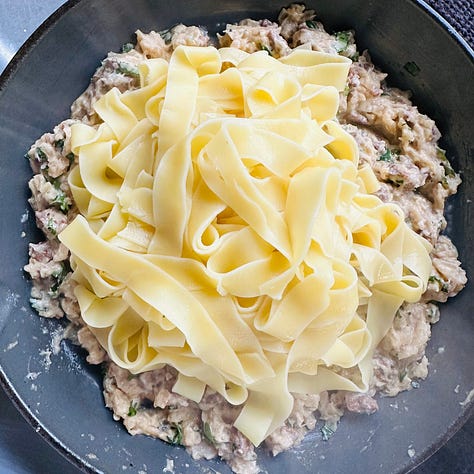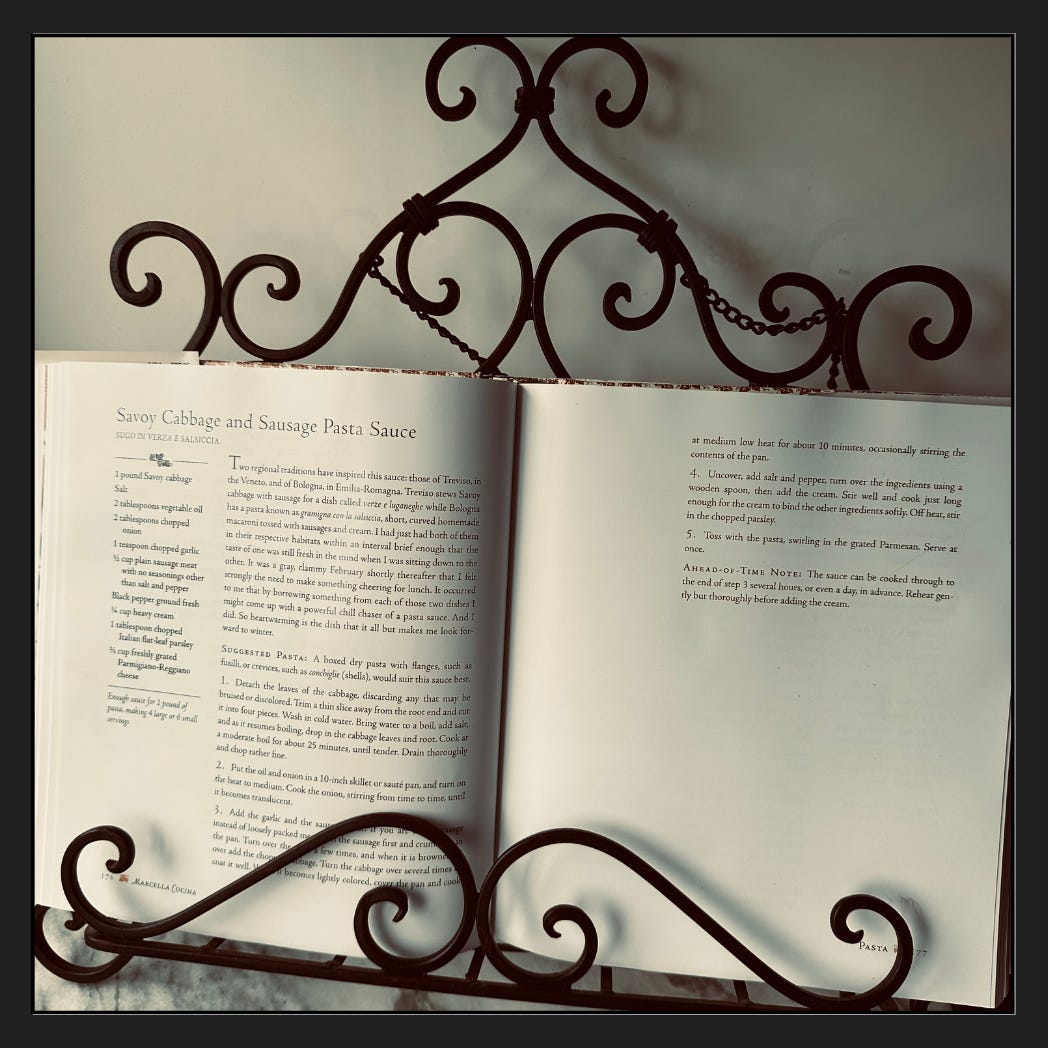Savoy Cabbage and Sausage Pasta Sauce -Sugo di Verza e Salsiccia
A rich and hearty Italian pasta sauce with Savoy cabbage, sausage, and cream—perfect for winter.
Some dishes feel like they were always meant to exist—born from the quiet logic of regional traditions and the comforting needs of the season. This pasta sauce is one of them, a beautiful convergence of two Northern Italian classics.
In Treviso, a beloved winter dish called verze e luganeghe pairs Savoy cabbage with sausage in a rich, slow-stewed preparation. Travel a little further south to Bologna, and you’ll find gramigna con la salsiccia, where crumbled sausage and cream cling to curled strands of fresh pasta. This recipe draws inspiration from both traditions, weaving their elements together into a dish that is humble yet deeply satisfying.
Marcella Hazan, always attuned to the connection between place and palate, found herself moving between these two regions in quick succession. She had just left Treviso, where cabbage and sausage had left a lasting impression on her taste memory, when she sat down in Bologna to a steaming plate of pasta with sausage and cream. The contrast and connection between the two dishes must have lingered because, back home on a bleak February day, she felt the need for something heartening—something that could wrap around her like a wool coat against the chill.
Her instinct led her to draw from both meals, borrowing the caramelised sweetness of slow-cooked cabbage from one and the indulgent touch of cream from the other. The result was this pasta sauce—robust, savoury, and rich enough to ward off winter’s bite. It’s a dish that speaks of necessity and intuition, of making something extraordinary out of a few well-chosen ingredients. She first shared the recipe in Marcella Cucina (1997), a cookbook filled with the wisdom of her years spent teaching Italian home cooking.



After cooking it myself, I can say with certainty that it’s a keeper. It’s the kind of cooking that belongs to cold days—the gentle sweetness of cabbage coaxed out by slow simmering, the richness of sausage balanced by just a whisper of cream, the way everything melts together to embrace the pasta. A dish that doesn’t call for extravagance, just patience and good ingredients.
The Right Pasta for the Sauce
To hold onto the sauce’s texture, a pasta with plenty of ridges or folds works best—fusilli, conchiglie, or even gramigna if you can find it. I used an egg fettuccine, which was delicious, though next time I’d opt for one of Marcella’s suggested shapes to better catch the sauce.



Savoy Cabbage and Sausage Pasta Sauce
Sugo di Verza e Salsiccia
Ingredients
(Makes enough sauce for 1 pound or 450gm of pasta, serving 4 generously or 6 as a lighter portion)
1 pound or 450gm Savoy cabbage
2 tablespoons vegetable oil
2 tablespoons finely chopped onion
1 teaspoon finely chopped garlic
½ cup plain sausage meat (only seasoned with salt and pepper)
Freshly ground black pepper
¼ cup heavy cream
1 tablespoon chopped Italian flat-leaf parsley
⅔ cup freshly grated Parmigiano-Reggiano



Method
Prepare the cabbage: Remove and discard any bruised or discoloured outer leaves. Trim a thin slice from the root end, then quarter the cabbage. Rinse thoroughly in cold water. Bring a pot of salted water to a boil, then add the cabbage and cook at a moderate boil for about 25 minutes, or until tender. Drain well and chop finely.
Build the base of the sauce: In a large skillet or sauté pan, warm the oil over medium heat. Add the chopped onion and cook, stirring occasionally, until it turns translucent.
Cook the sausage and cabbage: Stir in the garlic and sausage meat. If using whole sausages, remove the casing and crumble the meat directly into the pan. Let it brown, stirring occasionally. Once evenly coloured, add the chopped cabbage, stirring well to coat it in the sausage’s rendered fat. Cook over medium-low heat for about 10 minutes, stirring occasionally, until the cabbage takes on a lightly caramelised hue.
Finish the sauce: Uncover the pan, season with salt and freshly ground black pepper, then pour in the cream. Stir well, letting the cream gently bind everything together. Remove from the heat and stir in the chopped parsley.
Toss with pasta: Cook your chosen pasta in well-salted boiling water. Just before draining, reserve some of the starchy cooking water. Toss the pasta with the sauce, adding a ladle or two of the reserved water to loosen the mixture and help the sauce coat the pasta more evenly. Finish by stirring in the grated Parmigiano-Reggiano and serve immediately.



Cooking Notes & Adjustments
When I made this dish, I followed Marcella’s instructions to the letter. However, I found that the sauce needed a bit more liquid to reach the right consistency, it was on the stiffer side and benefited from an extra two ladles of pasta cooking water, stirred in off the heat. Next time, I’d be inclined to add one more ladle for an even silkier finish.
Marcella’s restraint with the cream is, in hindsight, well-judged. The sauce doesn’t need more richness, just a touch of looseness to fully coat the pasta. I also think the dish could handle a little extra parsley without throwing off the balance.
The result? A comforting, wintry pasta dish with smoky depth from the caramelised cabbage and the warmth of the sausage fat. It’s a recipe I’ll absolutely make again soon, in fact. When I served it, I paired it with a simple fennel and orange salad, which turned out to be the perfect bright counterpoint to the richness of the sauce.
A dish to keep in the winter rotation, one that, like Marcella, might just make you look forward to cold weather.
If you have enjoyed this post, I’d love you to subscribe and leave a comment. Please feel free to share and repost to spread the word about Cooking with Marcella.
Reference
Hazan, M. “Marcella Cucina”, Harper Collins, New York. 1997. Pp 176-7








This sounds delicious Lisa - and even I could make this one I think!!!!
Oh this brings back memories - it was a staple years ago when we first started to explore Italian dishes at home. Everyone enjoyed it because it's so simple yet so elegant.
It'll be lovely to revisit Marcella's sugo di verza with you - you make us feel like we're right there in the kitchen with her.